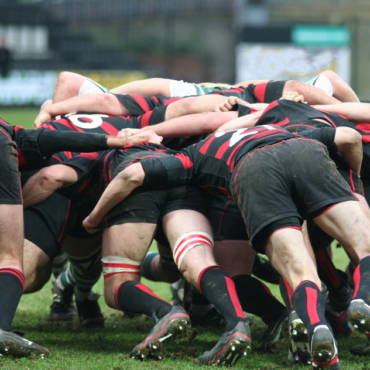Talent Identification – the way we currently do it – doesn’t work.
Here are some things that do and some ideas on how to do it better.
Remember this:
- Leadership is about the future;
- Management is about the present;
- Education is about the past.
So what’s this got to do with why Talent ID programs in the Western world are dismal failures?
There is a fundamental reason why TID – the way it is currently done – does not work in the western world.
TID programs are looking for “talent” based on what the research (i.e. research that was conducted some time in the past) has previously defined as “talent”.
However, sport is a constantly changing, evolving, dynamic environment and as such, any reliance on previous research and past methodologies in an attempt to identify something to forge the future is hopelessly out of place and largely irrelevant.
Talented athletes change sport.
They do things that no one before them has done. They see records not as barriers but as goals to be achieved and bettered and in doing so they change the sport. They set new standards of performance and change our beliefs about what’s possible.
So what good is setting up talent i.d. programs that at their foundation use the measurement techniques used to identify past generations of athletes?
What we need is a new approach to talent identification – one that incorporates a “futurism” approach into the identification and development programs.
A “futurist” approach in TID means looking at the future direction of the sport, predicting the types of athletes and athletic qualities which will prove successful in that future and identifying / developing talented kids who possess those qualities.
This is a fundamental shift that everyone involved in talent identification needs to make if they are going to be successful.
There are five core principles that need to be included in all successful talent identification programs:
- Physical talent gets you drafted or selected into elite squads or picked in talented athlete programs. However duration and quality of sporting career is dependent on character, values and perseverance. So the successful TID program which is seeking athletes who can sustain a career as a senior elite athlete needs to be more focused on personality, character, values and attitudes than physical abilities;
- The TID program needs to fit the demands of the sport – and not the other way around. Sporting federations and organisations must lead the direction of talent identification and not be dictated to by nationally driven and funded generic talent identification programs;
- Start at the end and work backwards. Start with a clear vision of what the future champions of the sport will need to be successful and work backwards from there. Predict the standards that will be world records and gold medal winning performances of 2012 / 2016 / 2020 and 2024 then use talent identification to find athletes capable of achieving those marks. Don’t waste time setting up talent id programs to find out what would have won in 2004!!!!
- Spend 100 times more on talent development than on talent identification. Talent is so much more than natural physical ability. Athletes only reach their potential through the total development of physical, mental, technical and tactical abilities. Real talent is harder to HIDE than find – the real skill is in helping talented athletes realise their full potential;
- Strive to find uniqueness and release the potential of individuals…don’t box athletes into current models of what “talent” is. The fundamental element in excellence is uniqueness. Greatness comes from individuality and being different – not from fitting a theoretical model of what “talent” is supposed to be. The best talent identification models must seek uniqueness, individuality and difference and not reduce everything to percentile rankings of what some data model prescribes as talent.
Funny thing is – most people in elite sport know these 5 principles – but for some reason sit back and wait for someone to come up with a magical talent id system which will unearth superstars by having them do a few jumps, a couple of runs and a sit and reach test!
Makes you wonder where we actually find the great ones doesn’t it?
Not really – we don’t find them………they find us.
Wayne Goldsmith




6 Comments
Another great blog Wayne.
I especially like your last comment.
I find what makes for great athletes are the intangables, therefore are harder to measure so it’s easier to ignore by the majority.
Because someone performs well in a set of test doesn’t mean it will automatically transfer into the real world. I’ve seen the opposite where people who do not perform that well in tests and measurements, yet get them in the real world situation and they blossom and boom.
So if you are picking for talent purely on measurement and test alone you are restricting yourself to the number of people you can choose from.
Cheers
Robin
Thanks Robin.
Never ceases to amaze me that all over the world the major sporting nations keep pumping millions into talent i.d. which is basically 90% physiological based testing and then wonder why their success rate is so poor.
The T.I.D concept or what I call T.O.P. – Talent Optimisation Process – is a great concept but not the way it is being done.
Thanks,
WG
Hi Wayne,
the NFL draft is upcoming, and they still can’t seem to get it right. San Francisco have got 2 #1 draft picks at QB- sat on the bench! That is despite all their scouts and resources. Now, how does a lowly state county club or school hope to get it right when selecting younger people- with no track record of success?
Very tricky, more luck than judgement still.
Good work Wayne
Hey James.
It is amazing that so many professional sporting competitions around the world have placed their faith in the draft system where physical and technical talent is worshipped on the alter of contracts, sponsorships and endorsements.
But, have a look at the history of professional sports – how many number 1, 2 and 3 draft picks ever really realise their full potential? And how many top draft picks become big problems off field and have issues with discipline, poor attitude and the whole gambit of social addictions?
Tell you something doesn’t it.
Thanks again,
WG
Effort should be done in setting up the environment. Once you have a positive environment in which to work in, everyone´s talents blossom. Talent will find its way to you then, because there is LOADS of good talent around.
In the NCAA basketball championships two low seeds made it to this years final four. One of them, Butler, made it to the championship game for the second straight year. Listening to their coaches, it was obvious that they have got their environment down right and the players within the system blossomed into high performers. Last year, Duke, which is one of the powerhouses in college basketball played Butler for the national title. Duke won, but Butler had an in and out last shot and lost by 2 points. It was interesting when they broke down the cost of both programs. Apparently Butler ran its entire basketball program for the cost of one Duke player. (Total cost of the program divided by the number of players on the team) It really isn´t only about money as you have been preaching on this blogg for ages.
Cheers!
Jer
Thanks JP.
I often work with pro teams who believe the answer to all problems is to pay high prices for quality athletes.
However, most of these athletes do not improve once they arrive at the team.
In other words, if the quality of the environment is less than the talent and ability of the player, the player’s standards and performance falls to match the environment.
Again the car analogy here is a good one.
If you buy a new Ferrari but then have it serviced by un-skilled mechanics, put low-grade fuel in it and put some local truck driver in it as driver, it will never realise its full potential.
Create the right environment then start recruiting the right athletes.
Thanks,
WG
Comments are closed.